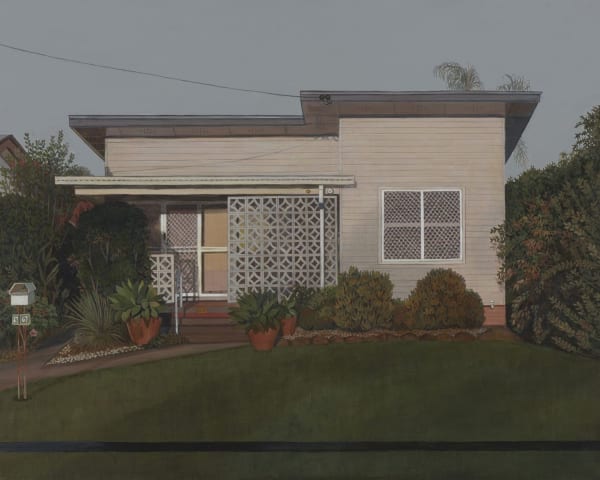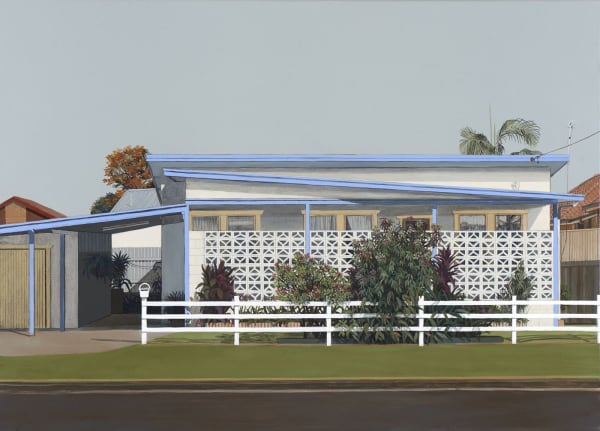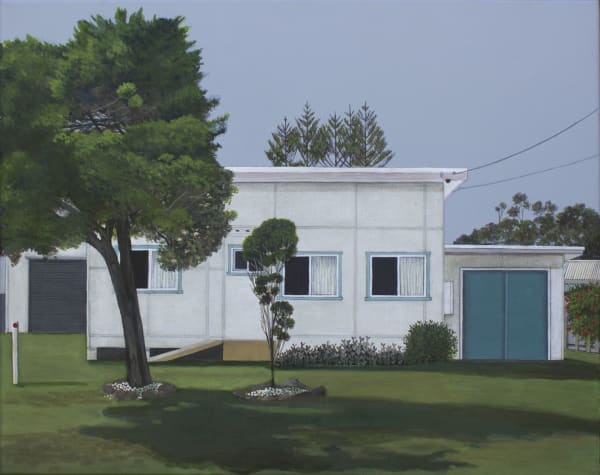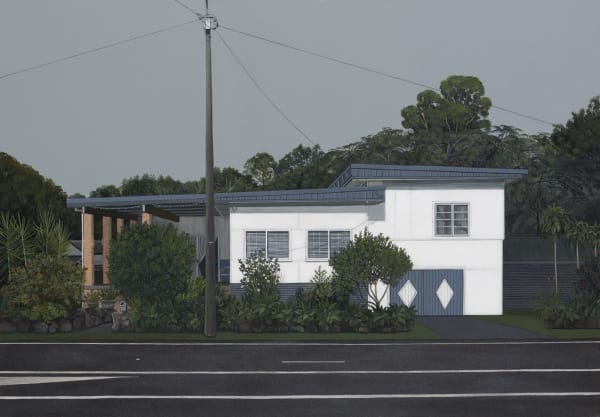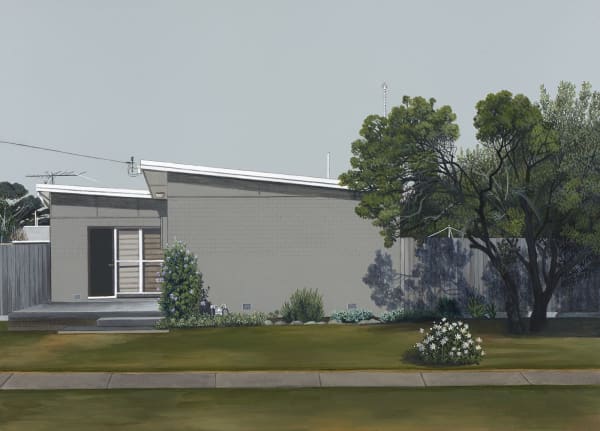Robyn Sweaney: Backwards Looking Forwards
-
 Robyn SweaneyAutumn Blues, 2018acrylic on polycotton40 x 50 cm, 43 x 53 cm (framed)
Robyn SweaneyAutumn Blues, 2018acrylic on polycotton40 x 50 cm, 43 x 53 cm (framed) -
 Robyn SweaneyBackwards Looking Forwards, 2018acrylic on polycotton70 x 100 cm, 73 x 103 cm (framed)
Robyn SweaneyBackwards Looking Forwards, 2018acrylic on polycotton70 x 100 cm, 73 x 103 cm (framed) -
 Robyn SweaneyBanksia (Brooms Head), 2018gouache on watercolour paper38 x 28.5 cm, 43 x 33 cm (framed)
Robyn SweaneyBanksia (Brooms Head), 2018gouache on watercolour paper38 x 28.5 cm, 43 x 33 cm (framed) -
 Robyn SweaneyBetween Ourselves, 2018acrylic on polycotton28 x 36 cm, 31 x 39 cm (framed)
Robyn SweaneyBetween Ourselves, 2018acrylic on polycotton28 x 36 cm, 31 x 39 cm (framed) -
 Robyn SweaneyBreathless, 2018acrylic on polycotton28 x 36 cm, 31 x 39 cm (framed)
Robyn SweaneyBreathless, 2018acrylic on polycotton28 x 36 cm, 31 x 39 cm (framed) -
 Robyn SweaneyContinuum, 2018acrylic on polycotton40 x 50 cm, 43 x 53 cm (framed)
Robyn SweaneyContinuum, 2018acrylic on polycotton40 x 50 cm, 43 x 53 cm (framed) -
 Robyn SweaneyFlannel Flowers (Red Rock), 2018gouache on watercolour paper38 x 28.5 cm, 43 x 33 cm (framed)
Robyn SweaneyFlannel Flowers (Red Rock), 2018gouache on watercolour paper38 x 28.5 cm, 43 x 33 cm (framed) -
 Robyn SweaneyFlowering Gum (Bolwarra), 2018gouache on watercolour paper38 x 28.5 cm, 43 x 33 cm (framed)
Robyn SweaneyFlowering Gum (Bolwarra), 2018gouache on watercolour paper38 x 28.5 cm, 43 x 33 cm (framed) -
 Robyn SweaneyFlowering Gum (Parkdale), 2018gouache on watercolour paper38 x 28.5 cm, 43 x 33 cm (framed)
Robyn SweaneyFlowering Gum (Parkdale), 2018gouache on watercolour paper38 x 28.5 cm, 43 x 33 cm (framed) -
 Robyn SweaneyHolding Pattern, 2018acrylic on polycotton50 x 70 cm, 53 x 73 cm (framed)
Robyn SweaneyHolding Pattern, 2018acrylic on polycotton50 x 70 cm, 53 x 73 cm (framed) -
 Robyn SweaneyHorizontal Emphasis, 2018acrylic on polycotton50 x 70 cm, 53 x 73 cm (framed)
Robyn SweaneyHorizontal Emphasis, 2018acrylic on polycotton50 x 70 cm, 53 x 73 cm (framed) -
 Robyn SweaneyLight Still in Shadows, 2018acrylic on polycotton40 x 50 cm, 43 x 53 cm (framed)
Robyn SweaneyLight Still in Shadows, 2018acrylic on polycotton40 x 50 cm, 43 x 53 cm (framed) -
 Robyn SweaneyMoving On, 2018acrylic on polycotton40 x 50 cm, 43 x 53 cm (framed)
Robyn SweaneyMoving On, 2018acrylic on polycotton40 x 50 cm, 43 x 53 cm (framed) -
 Robyn SweaneyPast Progressive, 2018acrylic on polycotton70 x 100 cm, 73 x 103 cm (framed)
Robyn SweaneyPast Progressive, 2018acrylic on polycotton70 x 100 cm, 73 x 103 cm (framed) -
 Robyn SweaneyShadowland, 2018acrylic on polycotton50 x 70 cm, 53 x 73 cm (framed)
Robyn SweaneyShadowland, 2018acrylic on polycotton50 x 70 cm, 53 x 73 cm (framed) -
 Robyn SweaneyThe Memory Keeper, 2018acrylic on polycotton50 x 70 cm, 53 x 73 cm (framed)
Robyn SweaneyThe Memory Keeper, 2018acrylic on polycotton50 x 70 cm, 53 x 73 cm (framed) -
 Robyn SweaneyThe Space Between, 2018acrylic on polycotton50 x 70 cm, 53 x 73 cm (framed)
Robyn SweaneyThe Space Between, 2018acrylic on polycotton50 x 70 cm, 53 x 73 cm (framed)
The tightly-choreographed paintings of Robyn Sweaney respond to the philosophical and ontological currency of the built environment. The artist’s preoccupation with the Australian architectural vernacular – particularly from the post war period – is rooted in an enduring fascination with the physiognomy of cultural identity. Domestic dwellings divulge more than their mere exteriors, functioning as physical incarnations of the aesthetic, ideological and social structures influencing human behaviour. Informed by travel through familiar and unfamiliar rural and suburban places, Sweaney finds that, ‘certain elements of place resonate an unexplainable reaction within me – something ignites deep within memory. The landscape is somehow opened up by the search itself and my response can reach beyond its visual appearance.’
The artist’s new body of work, ‘Backwards looking forwards’, explores how the past unfolds itself into present experience, shaping how we perceive the ever-changing urban landscape. ‘We cannot view the contemporary Australian landscape without considering the not-so-distant effects of past settlement, culturally and visually, or imagine how things will change in the future’, she explains. Focusing on quintessentially Australian modernist dwellings from the 1960s – with their flat, angled rooflines, floor-to-ceiling windows, open gardens and indoor-outdoor flow – the paintings function as ethnographic time capsules; nostalgic relics of a time when communities fostered spatial openness and an optimistic spirit. They embody the subtle undulations of a landscape sculpted by the fidgety hands of culture. With growing demands for housing, changing demographics and new lifestyles, the built environment is evolving in a way that relegates these retro dwellings to an irrevocably faraway past.
Silent and still, Sweaney’s mid-century vistas appear frozen in time, and yet there is also a sense of kinesis – as if glimpsed fleetingly through a car window. They are liminal spaces caught at the crossroads of time, containing within their suburban walls ongoing narratives of lives lived. There is a palpable uncanniness inhabiting these ubiquitous Australian snapshots, with human absence infiltrated by an elusive presence that is at once haunting and strangely comforting – a freshly manicured garden, an empty mailbox or a half-drawn curtain. Light, space, symmetry and balance converge as Sweaney engages with a traditional Western sensibility of landscape painting, employing single point perspective combined with side glimpses of receding objects to create an illusion of depth. Flat facades veneering surreal, single-toned skies juxtapose areas of highly detailed foliage, building textures and shadows falling on angular planes. Space and time are rendered ambiguous by a subdued palette that sits one degree from reality, and yet there is often a hint of the season – amber autumn leaves on a distant tree or spring daisies in bloom.
Capturing each residence with mimetic precision and sensitivity, Sweaney forces the viewer to focus on the bypassed, the forgotten and the ordinary. However, she denies us the ability to peer inside these alluring portals, their closed blinds and drawn curtains functioning as foils for our curiosity. We are left to imagine who stirs behind the façade; what lies below the surface – an apt metaphor for the multilayered construction of human identity. In ‘Backwards looking forwards’, Sweaney ultimately shows us the profound meaning that can be distilled from the mundane; the poetry from the prosaic. We witness the forgotten beauty that lingers deep within the aged walls of our collective history.
Robyn Sweaney has held thirteen solo exhibitions since 1992 and been involved in over ninety group exhibitions. She has been the finalist of major awards including in the Wynne Prize, the Sulman Prize, Portia Geach Memorial Award, the Moran Prize, the Salon Des Refusés, Fleurieu Art Prize, the Mosman Art Prize, the Paddington Art Prize and the Jacaranda Acquisitive Drawing Prize (JADA). Her work is held in public and private collections throughout Australia, such as The State Library of NSW, Artbank, The Gold Coast City Art Gallery, Tweed Regional Gallery, Stanthorpe, Grafton and Lismore Regional Galleries.




